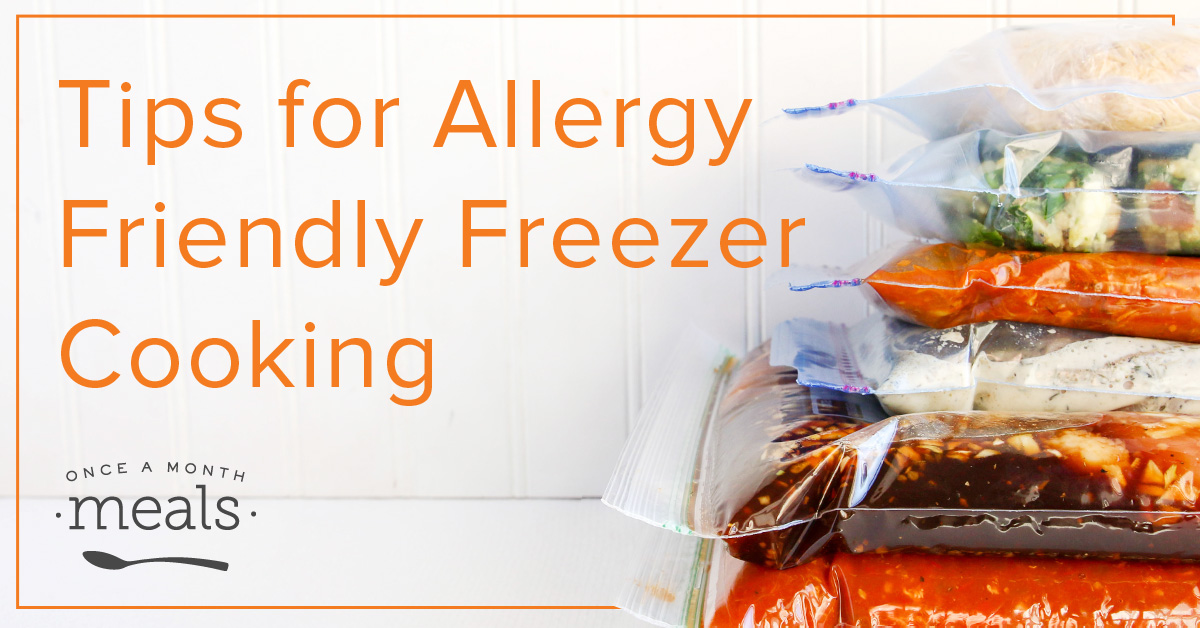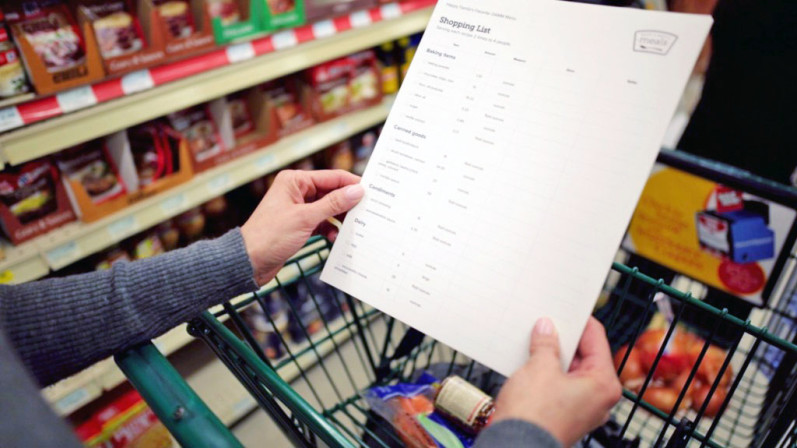
If the thought of serving allergy-friendly meals is overwhelming, let us help ease your load with these tips for allergy-friendly freezer cooking.
The biggest struggle as someone with a specialized diet or food allergy is what?
How to make your food lifestyle fit the reality of your life and the people in it.
I’m sure you ask yourself constantly, “Why is this so hard? Why does doing this feel so challenging all the time?” If I had to guess, there are at least a few reasons. Either:
- You don’t feel like an expert.
- You don’t feel like you have options.
- You feel like your doing it alone.
Let’s be honest, living with a specialized diet or food allergy is hard.
Don’t let anyone tell you differently.
Simply put, it’s hard when you feel the need to be a nutrition expert, your own built-in accountability partner, and full-time chef all so that you can plan and make meals that meet your needs. That said, we want to take a moment to encourage you today.
You can do this. You can eat well and within your means, without sacrificing convenience or your health.
We know getting a meal on the table can be stressful in itself, but add in food allergies or sensitivities and you can start to feel like a home-cooked meal is virtually impossible. You’ve thought of freezer cooking, but in your mind freezer cooking wouldn’t help because that is all casseroles filled with [name your allergy or allergies here].
Actually, you can freeze so much more than casseroles, including allergy friendly meals of all kinds. In fact, freezer cooking can help take some of the stress out of cooking allergy-friendly food because you always have something to eat even when you are busy, traveling, with friends, etc.
Tips for Living and Cooking for Food Allergies or Specialized Diets

Shopping for Ingredients
1. Understand what you’re trying to avoid.
Take some time (if you haven’t done this already), and dive into your needs. Really get to know what it is you’re dealing with: disease, diet, allergy, and more. Do you know the ingredients you’re trying to avoid and why?
Doing your research and fully understanding what you’re up against can really help in the midst of those last minute decisions you have to make. It also helps you feel better about the decisions you are making for your health and gives you confidence as you go about meal planning.
2. Learn how to read your food labels.
This is so crucial and relates to our first tip. The more you familiarize yourself with what you’re avoiding, the more you learn where it appears. If you know where it appears in food, you know what to look for on a food label.
What Should I Look For?
FALCPA-regulated allergens can be called out in one of three ways:
- In the ingredient list, using the allergen’s common name
- Using the word “Contains” followed by the name of the major food allergen—for example, “Contains milk, wheat”
- In the ingredient list in parentheses, when the ingredient is a less common form of the allergen—for example, “albumin (egg)”
With tree nuts, fish and crustacean shellfish, the specific type must be listed (e.g., almond, tuna, crab).
If you see your allergen featured in one of the above ways, it means the allergen is present in the food. Manufacturers must list a FALCPA-regulated allergen even if the amount is very small.
Non-FALCPA regulated allergens such as sesame and mustard may be present in a food, but missing from an ingredient list if they are part of a spice or flavoring. Instead, they may be covered by a general term such as “natural flavorings.”
*These instructions are cited from FARE: Food Allergy Research & Education. Click here to read the entire article on How to Read Food Labels.
3. Always double check ingredient labels.
There are some ingredients out there that are sometimes safe and sometimes not. Take for example soy sauce, which typically contains wheat unless you specifically buy the gluten-free version. Another example is oats, which are naturally gluten-free but must be certified because most oats are processed in facilities that also process wheat-containing products. Some packaged items do not contain allergens, but they have warnings that they have been processed in the same facility as an allergen!
When an ingredient like this is listed in a Once A Month Meals recipe, we will generally indicate the specific allergen-friendly ingredient to purchase (i.e. gluten-free soy sauce, certified gluten-free oats, etc.) But it is always up to you to be vigilant in checking labels at the grocery store! You don’t want to freeze a bunch of food, and then realize later you can’t eat it.
Planning and Preparing Meals
1. Plan the meals that are a struggle for you
When you are creating a meal plan, cook meals that will be of particular help to you. Make your freezer meals fit your life. For example, your go-to breakfast for the kids has always been cereal, but after a Celiac Disease diagnosis, you don’t know what to feed them. If you are always stumped on breakfast, then focus on stocking the freezer with breakfasts to eliminate stress in the morning before school.
Here is another example. You have always eaten take out with the office on work days, but since your allergy diagnosis, you can’t trust any of your favorite restaurants. Packing lunch has become a terrible drain. Create your own mini meal plan of 5-6 lunch recipes (recipes are doubled) to give you two weeks of lunches that can go straight from the freezer to the office!
2. Focus on ingredients you CAN have
It’s all about your mindset. It becomes much easier to meal plan around the large list of ingredients you can eat versus the handful that you can’t.
Our recommendation: make a list of some of your favorite things you can still have. Ingredients, meals, snacks, etc. Post it up on your fridge so the next time you start to get frustrated figuring out what to eat, you can quickly look at ideas to make your next meal something you really look forward to.
3. Prepare your favorites
Make food fun! Yes, sticking to a diet or avoiding a specific food can be extremely difficult, but start exploring and determine what you really like that still fits! This gives you something to look forward to and makes eating something exciting and nourishing.
4. Make adaptations to recipes you love
Are you gluten-free, but have a family favorite pasta dish you love to make? Simply swap out regular pasta for the gluten-free version! The same thing goes for soy sauce, and so much more. Either swap out the ingredient or leave it out altogether. Allergic to nuts? Leave them out of your recipe. This gives you complete freedom and autonomy to make recipes fit within your dietary restrictions.
5. Try something new
This is huge for those with allergies and difficult diets: Don’t be afraid to try something you’ve never tried before! It’s true. You don’t know what you don’t know, so we encourage you to take the leap and try something that’s new to you, but still compliant!
Eating Out and On-the-Go
1. Take full meals or ingredients with you
We know this can be taxing, but it will help you enjoy your experience so much more when eating and dining with others! Bringing your meal, snack, or salad dressing to the restaurant helps you feel confident about what’s in your food, gives you the security that it’s safe for your body, and helps you enjoy the experience with others!
It’s true. Planning and preparing are key. So when you cook ahead, like with freezer meals, you can have meals ready for those last minute occasions when you most need them.
2. Label meals accurately and keep an updated inventory.
We provide printable labels with all of our freezer cooking resources. But if you are cooking for multiple family members with different needs, you may need to make additional notes. Use colored markers or different container types to code your meals so you can grab them at a glance. Or add additional notes to your labels in case someone other than you is in charge of serving the meal.
You can use our freezer inventory worksheet to make additional notes and post them on outside of the freezer. It also helps you know when you are getting low on easy, allergy-friendly meals so you can plan your next cooking day.
3. Pre-make your meals into single servings
Eating away from home is a particular concern for those with allergies and food sensitivities. But you can remove the anxiety of packing school lunches, lunch at the office, vacations, and social gatherings by learning how to cook and package single serving freezer meals. Having these ready to go in the freezer means that you can eat safely on the go even at a moment’s notice.
Support for Success
1. Seek support from those with similar restrictions
Whether in a Facebook group, at your local clinic, fellow coworkers, or elsewhere, one of the keys to success is finding others who are going through something similar to you. Finding others pursuing the same lifestyle as you can help encourage you to stick to your plan, as well as discover new tips for success.
Know that here at Once A Month Meals our members get access to our members-only Community! Here is where our members get one-on-one support for learning how to freezer cook AND to stick to their diet! We’d love to have you join us!
2. Find accountability to actually prepare
Let’s be honest, it’s great to have support, but without accountability to stick to your goals, it means nothing! The next step after finding support is to find one person or even a small group of people you can be transparent and vulnerable with about your journey. Asking questions, sharing stories, and joining in one another successes is where true accountability and support is created!
Within the Once A Month Meals Community we have created groups for our members based on their specialty diets or allergies. There, our members join together to keep each other accountable to making one freezer cooking menu each month that complies to their diet. They share recipes, their wins, their failures, and much more to encourage one another to keep going.
3. Treat yourself when you succeed!
Following any type of dietary restriction is hard work, so give yourself some extra motivation by planning small rewards to look forward to as you continue to meet your dietary goals!
More Allergy Friendly Resources
- Packing Allergy Friendly School Lunches
- Allergy-Friendly Holiday Recipes
- 5 Tips for Allergy-Friendly Entertaining
- 25 Kid Friendly Gluten Free Recipes
- 50 Allergy Friendly Freezer Recipes
- Introduction to the Once a Month Meals Allergen Meal Plan (for detailed descriptions of each meal plan type)
